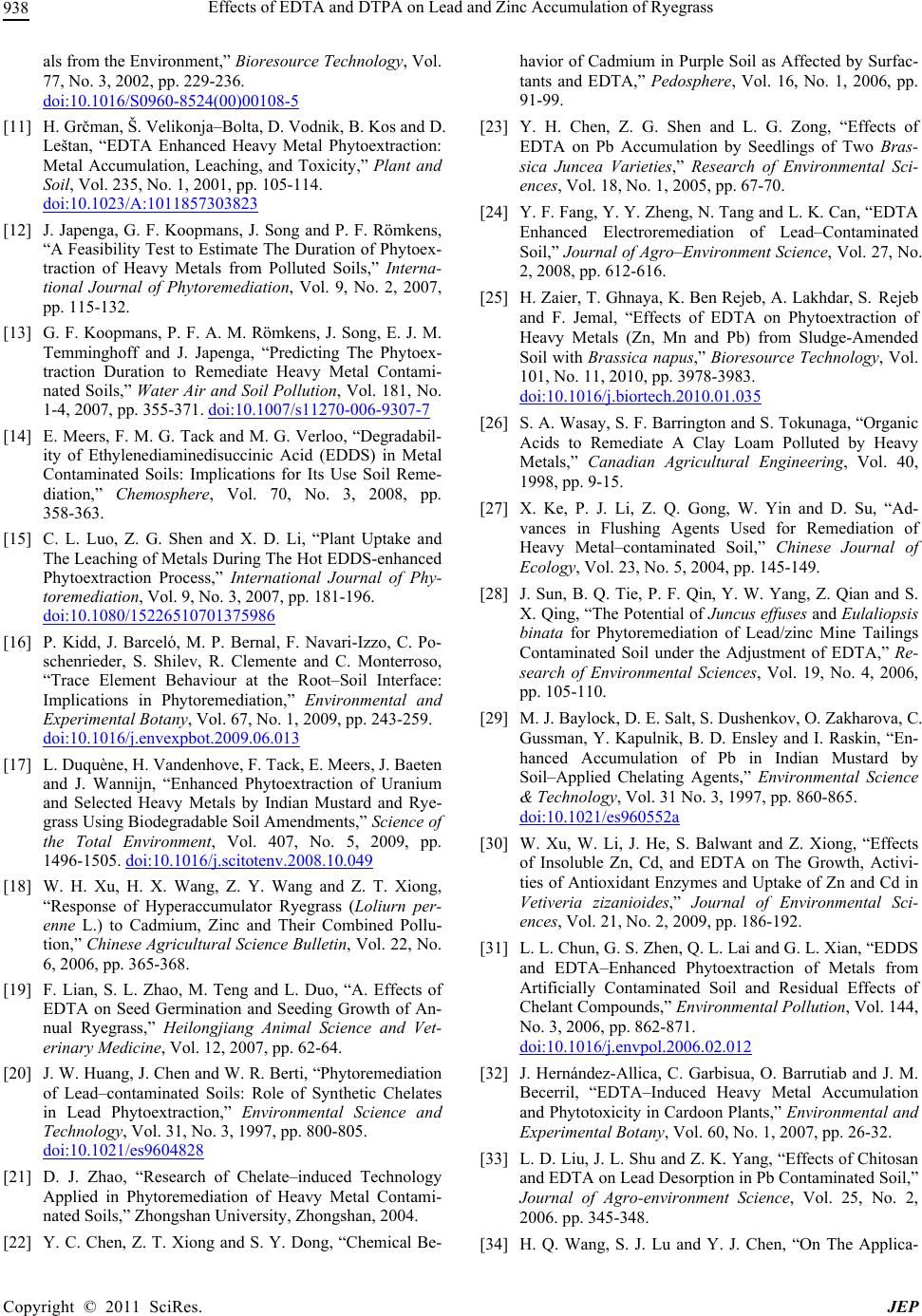
Effects of EDTA and DTPA on Lead and Zinc Accumulation of Ryegrass
938
als from the Environment,” Bioresource Technology, Vol.
77, No. 3, 2002, pp. 229-236.
doi:10.1016/S0960-8524(00)00108-5
[11] H. Grčman, Š. Velikonja–Bolta, D. Vodnik, B. Kos and D.
Leštan, “EDTA Enhanced Heavy Metal Phytoextraction:
Metal Accumulation, Leaching, and Toxicity,” Plant and
Soil, Vol. 235, No. 1, 2001, pp. 105-114.
doi:10.1023/A:1011857303823
[12] J. Japenga, G. F. Koopmans, J. Song and P. F. Römkens,
“A Feasibility Test to Estimate The Duration of Phytoex-
traction of Heavy Metals from Polluted Soils,” Interna-
tional Journal of Phytoremediation, Vol. 9, No. 2, 2007,
pp. 115-132.
[13] G. F. Koopmans, P. F. A. M. Römkens, J. Song, E. J. M.
Temminghoff and J. Japenga, “Predicting The Phytoex-
traction Duration to Remediate Heavy Metal Contami-
nated Soils,” Water Air and Soil Pollution, Vol. 181, No.
1-4, 2007, pp. 355-371. doi:10.1007/s11270-006-9307-7
[14] E. Meers, F. M. G. Tack and M. G. Verloo, “Degradabil-
ity of Ethylenediaminedisuccinic Acid (EDDS) in Metal
Contaminated Soils: Implications for Its Use Soil Reme-
diation,” Chemosphere, Vol. 70, No. 3, 2008, pp.
358-363.
[15] C. L. Luo, Z. G. Shen and X. D. Li, “Plant Uptake and
The Leaching of Metals During The Hot EDDS-enhanced
Phytoextraction Process,” International Journal of Phy-
toremediation, Vol. 9, No. 3, 2007, pp. 181-196.
doi:10.1080/15226510701375986
[16] P. Kidd, J. Barceló, M. P. Bernal, F. Navari-Izzo, C. Po-
schenrieder, S. Shilev, R. Clemente and C. Monterroso,
“Trace Element Behaviour at the Root–Soil Interface:
Implications in Phytoremediation,” Environmental and
Experimental Botany, Vol. 67, No. 1, 2009, pp. 243-259.
doi:10.1016/j.envexpbot.2009.06.013
[17] L. Duquène, H. Vandenhove, F. Tack, E. Meers, J. Baeten
and J. Wannijn, “Enhanced Phytoextraction of Uranium
and Selected Heavy Metals by Indian Mustard and Rye-
grass Using Biodegradable Soil Amendments,” Science of
the Total Environment, Vol. 407, No. 5, 2009, pp.
1496-1505. doi:10.1016/j.scitotenv.2008.10.049
[18] W. H. Xu, H. X. Wang, Z. Y. Wang and Z. T. Xiong,
“Response of Hyperaccumulator Ryegrass (Loliurn per-
enne L.) to Cadmium, Zinc and Their Combined Pollu-
tion,” Chinese Agricultural Science Bulletin, Vol. 22, No.
6, 2006, pp. 365-368.
[19] F. Lian, S. L. Zhao, M. Teng and L. Duo, “A. Effects of
EDTA on Seed Germination and Seeding Growth of An-
nual Ryegrass,” Heilongjiang Animal Science and Vet-
erinary Medicine, Vol. 12, 2007, pp. 62-64.
[20] J. W. Huang, J. Chen and W. R. Berti, “Phytoremediation
of Lead–contaminated Soils: Role of Synthetic Chelates
in Lead Phytoextraction,” Environmental Science and
Technology, Vol. 31, No. 3, 1997, pp. 800-805.
doi:10.1021/es9604828
[21] D. J. Zhao, “Research of Chelate–induced Technology
Applied in Phytoremediation of Heavy Metal Contami-
nated Soils,” Zhongshan University, Zhongshan, 2004.
[22] Y. C. Chen, Z. T. Xiong and S. Y. Dong, “Chemical Be-
havior of Cadmium in Purple Soil as Affected by Surfac-
tants and EDTA,” Pedosphere, Vol. 16, No. 1, 2006, pp.
91-99.
[23] Y. H. Chen, Z. G. Shen and L. G. Zong, “Effects of
EDTA on Pb Accumulation by Seedlings of Two Bras-
sica Juncea Varieties,” Research of Environmental Sci-
ences, Vol. 18, No. 1, 2005, pp. 67-70.
[24] Y. F. Fang, Y. Y. Zheng, N. Tang and L. K. Can, “EDTA
Enhanced Electroremediation of Lead–Contaminated
Soil,” Journal of Agro–Environment Science, Vol. 27, No.
2, 2008, pp. 612-616.
[25] H. Zaier, T. Ghnaya, K. Ben Rejeb, A. Lakhdar, S. Rejeb
and F. Jemal, “Effects of EDTA on Phytoextraction of
Heavy Metals (Zn, Mn and Pb) from Sludge-Amended
Soil with Brassica napus,” Bioresource Technology, Vol.
101, No. 11, 2010, pp. 3978-3983.
doi:10.1016/j.biortech.2010.01.035
[26] S. A. Wasay, S. F. Barrington and S. Tokunaga, “Organic
Acids to Remediate A Clay Loam Polluted by Heavy
Metals,” Canadian Agricultural Engineering, Vol. 40,
1998, pp. 9-15.
[27] X. Ke, P. J. Li, Z. Q. Gong, W. Yin and D. Su, “Ad-
vances in Flushing Agents Used for Remediation of
Heavy Metal–contaminated Soil,” Chinese Journal of
Ecology, Vol. 23, No. 5, 2004, pp. 145-149.
[28] J. Sun, B. Q. Tie, P. F. Qin, Y. W. Yang, Z. Qian and S.
X. Qing, “The Potential of Juncus effu ses and Eulaliopsis
binata for Phytoremediation of Lead/zinc Mine Tailings
Contaminated Soil under the Adjustment of EDTA,” Re-
search of Environmental Sciences, Vol. 19, No. 4, 2006,
pp. 105-110.
[29] M. J. Baylock, D. E. Salt, S. Dushenkov, O. Zakharova, C.
Gussman, Y. Kapulnik, B. D. Ensley and I. Raskin, “En-
hanced Accumulation of Pb in Indian Mustard by
Soil–Applied Chelating Agents,” Environmental Science
& Technology, Vol. 31 No. 3, 1997, pp. 860-865.
doi:10.1021/es960552a
[30] W. Xu, W. Li, J. He, S. Balwant and Z. Xiong, “Effects
of Insoluble Zn, Cd, and EDTA on The Growth, Activi-
ties of Antioxidant Enzymes and Uptake of Zn and Cd in
Vetiveria zizanioides,” Journal of Environmental Sci-
ences, Vol. 21, No. 2, 2009, pp. 186-192.
[31] L. L. Chun, G. S. Zhen, Q. L. Lai and G. L. Xian, “EDDS
and EDTA–Enhanced Phytoextraction of Metals from
Artificially Contaminated Soil and Residual Effects of
Chelant Compounds,” Environmental Pollution, Vol. 144,
No. 3, 2006, pp. 862-871.
doi:10.1016/j.envpol.2006.02.012
[32] J. Hernández-Allica, C. Garbisua, O. Barrutiab and J. M.
Becerril, “EDTA–Induced Heavy Metal Accumulation
and Phytotoxicity in Cardoon Plants,” Environmental and
Experimental Botany, Vol. 60, No. 1, 2007, pp. 26-32.
[33] L. D. Liu, J. L. Shu and Z. K. Yang, “Effects of Chitosan
and EDTA on Lead Desorption in Pb Contaminated Soil,”
Journal of Agro-environment Science, Vol. 25, No. 2,
2006. pp. 345-348.
[34] H. Q. Wang, S. J. Lu and Y. J. Chen, “On The Applica-
Copyright © 2011 SciRes. JEP